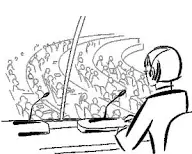by Hayley Guest
Simultaneous interpreting is the real-time translation of a speaker’s statements from one language to another. You probably already know how simultaneous and consecutive interpretation differ (if not, check this out), but did you know there are different kinds of simultaneous interpretation?
Read on to discover the different settings in which simultaneous interpreting can be used.
NO EQUIPMENT NEEDED
Simultaneous interpreting can be done either with or without the support of audio equipment. The necessity depends on the setting of interpretation and the reason for interpreting.
The interpretation of one particular group of languages rarely needs equipment: sign languages. Take American Sign Language (ASL), for example. Since ASL is a silent language, it lends itself easier to simultaneous interpreting than two spoken languages would. ASL is often interpreted simultaneously in conference, workshop, or lecture-style settings.
Simultaneous interpreting is also used is in court settings. Imagine a defendant is Spanish speaking and needs an interpreter to understand her court trial. The interpreter might sit behind or just to the side of the defendant. The interpreter listens to the court proceedings in English and whispers the Spanish interpretation in the defendant’s ear. This kind of interpretation is called chuchotage, or whisper interpreting. Since whispering puts strain on the interpreter’s vocal cords, chuchotage works best for court appointments lasting less than two hours long.
EQUIPMENT NEEDED
Sometimes simultaneous interpreting requires equipment. Interpreting equipment is usually needed where some people in a group need interpretation but others do not. One such setting is in tour groups. If the tour guide speaks a different language than the tourists, an interpreter and portable interpreting equipment come in handy. The interpreter wears a portable transmitter that broadcasts to receivers that tourists wear around their necks. Tourists attach headphones to the receiver through which they can listen to the interpretation.
Finally, there are some settings where more substantial interpreting equipment is required. Stationary interpreting equipment is needed in settings where a large group of people need interpretation. Such settings may include large presentations, events, or conferences. In these cases, interpreters interpret from a sound-proof booth. Interpreters receive the speaker’s audio through direct feed into the booth, and they interpret into the microphone. The interpreted audio is transmitted via radio waves to receivers which each audience member has. Audience members can then listen to the interpretation from their receiver.
The use of a booth in large-audience settings allows interpreters to concentrate on the presenter’s speech and render a clear interpretation without residual sound from the audience. Though portable equipment can technically be used in large audience settings, the quality of interpretation suffers, and interpreters are less likely to work in non-soundproofed conditions.
For more information about simultaneous interpreting or other services at LTC, please call us at 888-456-1626 or visit us online at LTCLanguageSolutions.com.



